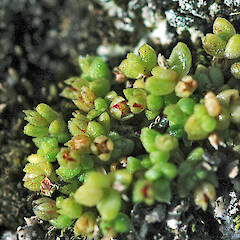Crassula manaia
Synonyms
None
Family
Crassulaceae
Flora category
Vascular – Native
Endemic taxon
Yes
Endemic genus
No
Endemic family
No
Structural class
Herbs - Dicotyledons other than Composites
NVS code
The National Vegetation Survey (NVS) Databank is a physical archive and electronic databank containing records of over 94,000 vegetation survey plots - including data from over 19,000 permanent plots. NVS maintains a standard set of species code abbreviations that correspond to standard scientific plant names from the Ngä Tipu o Aotearoa - New Zealand Plants database.
CRAMAN
Current conservation status
The conservation status of all known New Zealand vascular plant taxa at the rank of species and below were reassessed in 2017 using the New Zealand Threat Classification System (NZTCS) – more information about this can be found on the NZTCS website. This report includes a statistical summary and brief notes on changes since 2012 and replaces all previous NZTCS lists for vascular plants.
Please note, threat classifications are often suggested by authors when publications fall between NZTCS assessment periods – an interim threat classification status has not been assessed by the NZTCS panel.
- Conservation status of New Zealand indigenous vascular plants, 2017 . 2018. Peter J. de Lange, Jeremy R. Rolfe, John W. Barkla, Shannel P. Courtney, Paul D. Champion, Leon R. Perrie, Sarah M. Beadel, Kerry A. Ford, Ilse Breitwieser, Ines Schönberger, Rowan Hindmarsh-Walls, Peter B. Heenan and Kate Ladley. Department of Conservation. Source: NZTCS and licensed by DOC for reuse under the Creative Commons Attribution 4.0 International licence.
2017 | Threatened – Nationally Vulnerable | Qualifiers: DP, EF, RR, Sp
Previous conservation statuses
2012 | Threatened – Nationally Vulnerable | Qualifiers: DP, EF, RR, Sp
2009 | Threatened – Nationally Vulnerable | Qualifiers: DP, EF, RR, Sp
2004 | Gradual Decline
Distribution
Endemic. Confined to the south Taranaki coast.
Habitat
Coastal turf and associated fine silts and gravels. Often found mixed through the grass Zoysia minima.
Detailed description
Minute annual to short-lived perennial herb forming small, pale green moss-like diffuse to dense, compact mats. Stems filiform, rooting at nodes, scarcely ascending at tips, much branched. Leaves succulent, fused at base 1-2(-3.5) x 0.6-1 mm, 0.5-0.6 mm thick, elliptic-lanceolate to elliptic-ovate, flat above, convex beneath, apex obtuse to subacute. Flowers soliatry in leaf axils, 4-merous, 1-1.3 mm diam., pedicels < 1 mm elongated to 3 mm at fruiting. Calyx lobes 0.7-1 x 0.4 mm, ovate-lanceolate, ovate-elliptic or broadly ovate, acute to subacute. Petals 0.6-0.9 x 0.3 mm, triangular-ovate, minute, pink, reddish or greenish-white, about length of calyx. Folicle smooth. Seed 0.3-0.35 mm.
Similar taxa
Similar to C. mataikona with which it sometimes grows. C. mataikona is larger forming more diffuse mats, its stems are ascending to erect from near the base, 10-30 mm tall. The leaves form dense aggregations along portions of otherwise exposed stem, while there are (1-)2 flowers per leaf axil. Flowers often appear densely clustered because of subsidiary leaves, which in turn often bear flowers. C. mataikona seed are slightly larger (0.35-0.43 mm). Both have different nrDNA ITS sequences.
Flowering
Flowers may be found throughout the year
Flower colours
Red/Pink, White
Fruiting
Fruit may be found throughout the year
Life cycle
Minute follicles are dispersed by wind and water and possiblty also by attachment (Thorsen et al., 2009).
Propagation technique
Easy from small rooted pieces which readily self-sow and establish themselves if conditions are suitable. Best in a small pot, kept weed free, moist and placed in a sunny place. In some gardens this species has proved very aggressive and has become a weed of gravel driveways and asphalt footpaths.
Threats
Extremely vulnerable to habitat loss through the spread of taller, faster growing weeds. Its survival depends entirely on a delicate balance of maintaining some level of disturbance to retain the open coast turf communities it requires and yet not allowing too much disturbance which can easily destroy these sensitive habitats.
Etymology
crassula: From the Latin crassus ‘thick’, meaning ‘rather thick’
Where To Buy
Not commercially available.
Attribution
Fact Sheet prepared by P.J. de Lange (28 July 2005). Description based on Druce & Sykes (1988).
References and further reading
Druce, A.P.; Sykes, W. R. 1988: A new species of Crassula L. in New Zealand. New Zealand Journal of Botany 26: 477-478.
Thorsen, M. J.; Dickinson, K. J. M.; Seddon, P. J. 2009. Seed dispersal systems in the New Zealand flora. Perspectives in Plant Ecology, Evolution and Systematics 11: 285-309
NZPCN Fact Sheet citation
Please cite as: de Lange, P.J. (Year at time of access): Crassula manaia Fact Sheet (content continuously updated). New Zealand Plant Conservation Network. https://www.nzpcn.org.nz/flora/species/crassula-manaia/ (Date website was queried)







